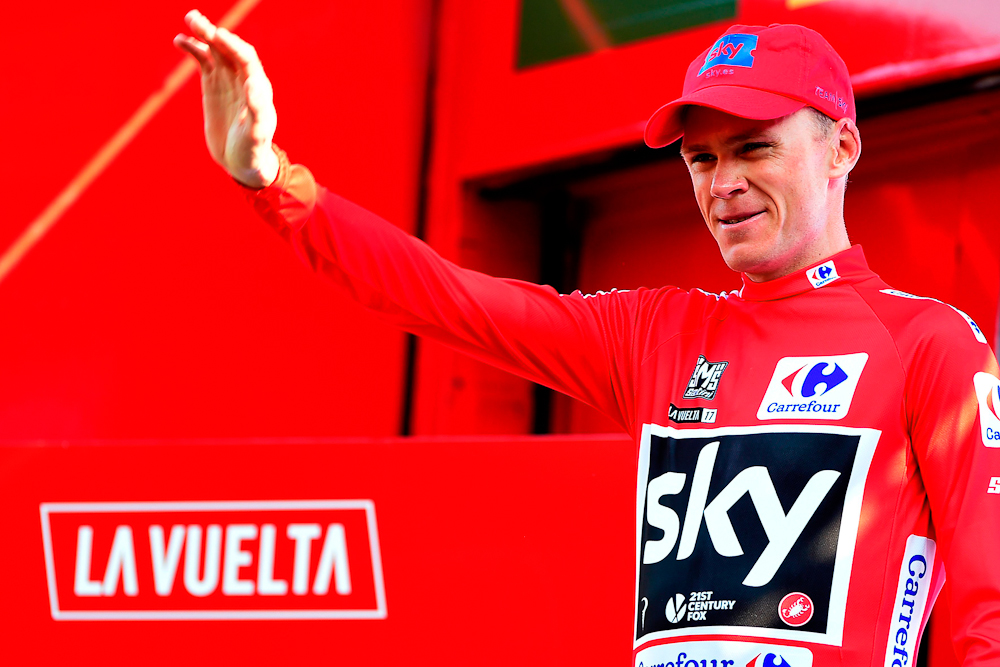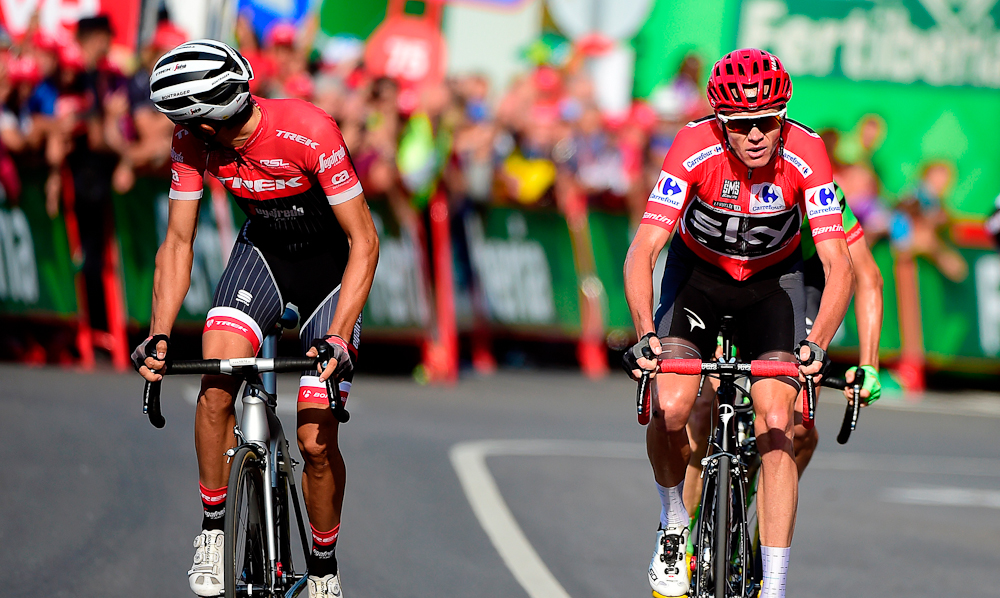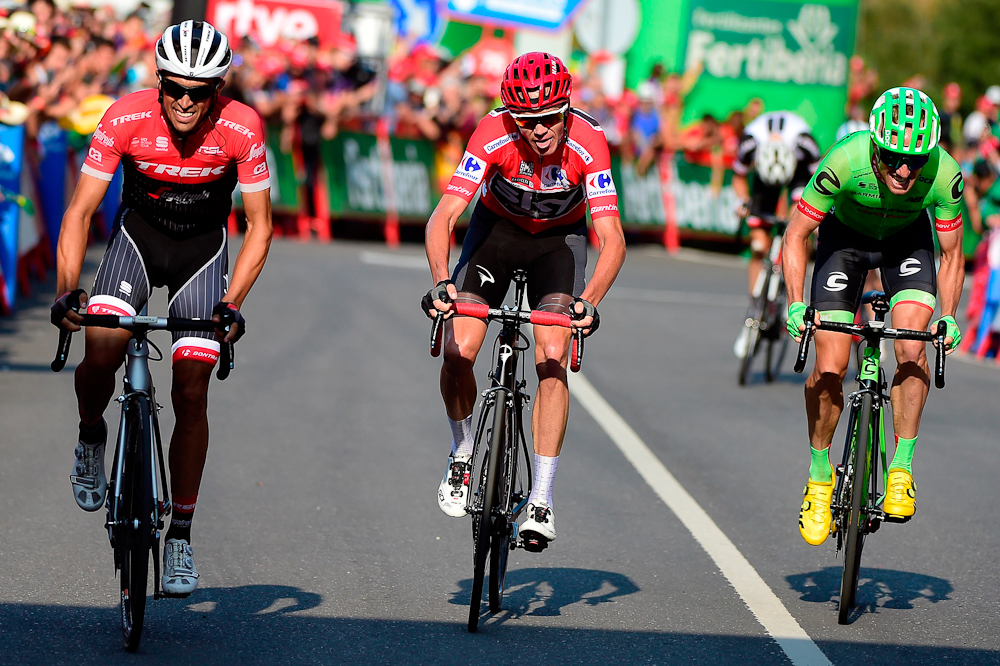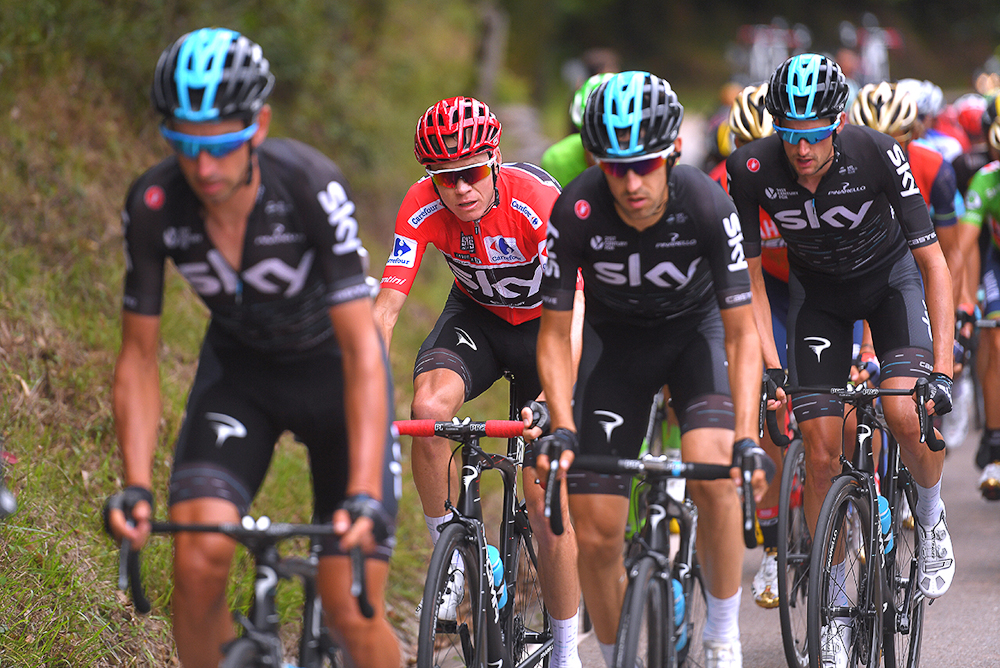A lot of explaining to do: The questions raised by the Chris Froome salbutamol case
Adverse analytical finding places Team Sky under threat




What a difference two weeks make. On November 29, Chris Froome appeared on an eight-second video clip during the Giro d'Italia presentation in Milan to confirm that he would participate in next year's edition of the race in an attempt to become only the third man in history to hold all three Grand Tour titles at the same time.
Froome refused to apply for TUE at Tour de France despite illness
Chris Froome confirms Giro d'Italia participation
Chris Froome returns adverse analytical finding for salbutamol
Will Chris Froome's salbutamol result sink Team Sky?
Nibali: Chris Froome salbutamol case is bad news for cycling
Vuelta a Espana organisers call for 'extreme caution' after Froome salbutamol result
Chris Froome: I haven't broken any rules
'A scandal' - Tony Martin sounds off on Chris Froome's salbutamol case
Movistar steer clear of Froome salbutamol case at team launch
Thanks to the reporting of Le Monde and The Guardian, it emerged on Wednesday morning that Froome's Grand Tour challenge may not survive long in the record books as the winner of the 2017 Vuelta a España. An adverse analytical finding for salbutamol in the final week of the race – a result confirmed by analysis of the B sample – means that Froome is facing a potential doping ban if he cannot provide a sufficient explanation.
Froome's sample from stage 18 of the Vuelta to Santo Toribio de Liébana contained twice the permissible limit of salbutamol. In recent years, riders have served suspensions for returning samples containing lower levels of the substance, and it seems difficult to imagine that Froome can escape a sanction even if he manages to argue that the adverse analytical finding was the result of negligence rather than a deliberate attempt to enhance performance.
As Froome's career and his legacy as a four-time Tour de France winner hang in the balance, Cyclingnews takes a look at some of the questions surrounding the case.
What is salbutamol and why is it prohibited?
Salbutamol is a Beta 2 agonist that is commonly used to treat asthma by relaxing the muscles of the airways into the lungs, making it easier to breathe. Salbutamol is typically delivered via an inhaler – it is commonly marketed as Ventolin – or nebuliser, but is also available as a pill and as an intravenous solution.
Salbutamol's properties as a bronchodilator mean that it is on the World Anti-Doping Agency's (WADA) prohibited list, but it is permitted for therapeutic reasons. Since 2010, athletes no longer need to obtain a Therapeutic Use Exemption (TUE) for salbutamol if it is used within WADA limits.
Get The Leadout Newsletter
The latest race content, interviews, features, reviews and expert buying guides, direct to your inbox!
Athletes are not permitted to inhale more than 1,600 micrograms of salbutamol over a period of 24 hours and no more than 800 micrograms in 12 hours. An athlete faces a potential anti-doping sanction if a urine sample contains a level of salbutamol that exceeds 1,000 nanograms per millilitre (ng/ml). Froome's level of 2,000ng/ml is thus double the amount WADA permits.
The UCI statement describes salbutamol as a 'Specified Substance.' What is the difference between a Specified and Non-Specified substance?
It is important to note that both Specified Substances and Non-Specified Substances are simply sub-classifications of prohibited substances. The distinction between them is, as WADA notes, "important only in the sanctioning process." WADA is also careful to stress that a Specified Substance is not necessarily a less effective performance enhancer than a Non-Specified substance.
"The purpose of the sub-classifications of 'Specified' or 'Non-Specified' on the Prohibited List is to recognize that it is possible for a substance to enter an athlete's body inadvertently, and therefore allow a tribunal more flexibility when making a sanctioning decision," states WADA.
"A 'Specified Substance' is a substance which potentially allows, under defined conditions, for a greater reduction of a sanction when an athlete tests positive for that particular substance."
Where does this leave Froome?
An adverse analytical finding for a Specified Substance – even when confirmed by the B sample, as is the case for Froome – does not trigger a mandatory provisional suspension. However, the onus is now on Froome to offer an explanation for his abnormally high level of salbutamol. If he fails to do so, then he would face a suspension of up to two years and would be stripped of his Vuelta victory.
Froome must now show through a controlled pharmacokinetic study that his urine levels were the result of taking the maximum allowed dose or less by inhalation if he hopes to escape a suspension.
When Diego Ulissi returned a slightly lower level of salbutamol in an anti-doping control at the 2014 Giro d'Italia, he was thus required to undergo a battery of tests in Lausanne in order to provide an explanation for his abnormally high levels.
Ulissi was ultimately found guilty of negligence rather than deliberately seeking to enhance his performance, but he was nonetheless handed a nine-month ban – although his two stage wins at the 2014 Giro remain on his palmarès. Moldovan rider Alexandr Pliuschin also received a nine-month ban after he returned an adverse analytical finding for salbutamol in 2014.
What is Froome's defence?
Froome claims that his elevated levels of salbutamol after stage 18 of the Vuelta were the result of increasing his inhaler use in order to counteract worsening asthma in the final week of the race.
The UCI's guidance on salbutamol states, "For inhaled salbutamol, you must obtain a TUE if you need to take more than 1600 micrograms over 24 hours in divided doses not to exceed 800 micrograms over 12 hours starting from any dose."
However, from the statement released by Team Sky on Wednesday, it does not appear that Froome applied for a TUE in order to increase his dosage.
"It is well known that I have asthma and I know exactly what the rules are. I use an inhaler to manage my symptoms (always within the permissible limits) and I know for sure that I will be tested every day I wear the race leader's jersey," Froome said in a statement on Wednesday. "My asthma got worse at the Vuelta so I followed the team doctor's advice to increase my Salbutamol dosage. As always, I took the greatest care to ensure that I did not use more than the permissible dose."
Froome's use of an inhaler first entered the public domain when he was filmed puffing on one during the 2014 Critérium du Dauphiné. In an interview with Paul Kimmage for the Sunday Independent the following week, Froome revealed that he suffered from asthma and described his inhaler use. "I take my inhaler every day," Froome said. "[I take] Ventolin only if I've got effort. Fluticasone is a daily one, more a preventative, so I take two sprays."
In his autobiography, The Climb, ghost-written by David Walsh and published just weeks earlier in May 2014, Froome made no reference whatsoever to a chronic, performance-diminishing asthmatic condition.
- Chris Froome returns adverse analytical finding for salbutamol
- Will Chris Froome's salbutamol result sink Team Sky?
- Vuelta a Espana organisers call for 'extreme caution' after Froome salbutamol result
- Nibali: Chris Froome salbutamol case is terrible for the sport
- Froome's salbutamol case and what it means for him, Team Sky and cycling - Podcast
Froome returned the adverse analytical finding on September 7 and was informed on September 20. Why did Team Sky and the UCI not comment on the case until now?
In a dreary echo of Alberto Contador's positive test for Clenbuterol on the 2010 Tour de France, it appears the UCI would not have gone public on the news of Froome's adverse analytical finding for salbutamol had the information not been leaked to the press, namely newspapers The Guardian and Le Monde.
Not by coincidence, the UCI and Team Sky statements on Wednesday morning each appeared shortly before Le Monde and The Guardian published their stories. It is thus safe to assume that the case would not have entered the public domain at this point were it not for the work of journalists at the two newspapers.
In its statement on Wednesday morning, the UCI noted that while it voluntarily reports provisional suspensions on its website, Froome is not under suspension, and thus the governing body felt it was not compelled to publicise the case.
This, in turn, raises the obvious and important question as to how many such cases of elevated levels of salbutamol are resolved behind closed doors between riders and the UCI's Cycling Anti-Doping Foundation. It is possible that other such cases have ultimately gone unreported in the past.
By a similar token, it raises the question as to whether Froome – a long-time inhaler user – has previously recorded elevated levels of salbutamol in other anti-doping controls taken during his career.
Froome and Team Sky have stated that the sample in question from stage 18 was the only abnormal sample from the 2017 Vuelta.
Why did Froome publicly announce his decision to ride the 2018 Giro d'Italia when he is facing a possible doping ban?
It seems astonishing that Froome could so cheerily announce his intention to ride next year's Giro – and pick up a rumoured €2 million appearance fee in the process – while facing a potential doping ban. It may be that Froome was simply confident the matter would be resolved privately before the beginning of the 2018 season, but even a reduced ban of the kind handed to Ulissi would prevent the Team Sky rider from taking the start line in Israel on May 4.
Even if Froome escapes a sanction, his credibility has been damaged irretrievably. If the case drags on into May, one wonders whether Froome's welcome will be as lucrative as originally envisaged.
How does the case affect Team Sky and their future?
Team Sky's reputation has taken a battering in the year or so since the Fancy Bears hack demonstrated that Bradley Wiggins had availed of a TUE for cortisone en route to Tour de France victory in 2012. The perhaps never-to-be-resolved case of the Jiffy Bag, Josh Edmondson's allegation that the team had overlooked a violation of the no needles policy, and the inexplicable delivery of a batch of testosterone patches to the velodrome in Manchester have all severely damaged the credibility of Team Sky and brought the tenability of manager Dave Brailsford's position into question.
A confirmed positive test and doping ban would see Froome fired from the team as per their supposed zero-tolerance policy – and might very well persuade Sky to pull the plug on its sponsorship of the team altogether.

Barry Ryan was Head of Features at Cyclingnews. He has covered professional cycling since 2010, reporting from the Tour de France, Giro d’Italia and events from Argentina to Japan. His writing has appeared in The Independent, Procycling and Cycling Plus. He is the author of The Ascent: Sean Kelly, Stephen Roche and the Rise of Irish Cycling’s Golden Generation, published by Gill Books.